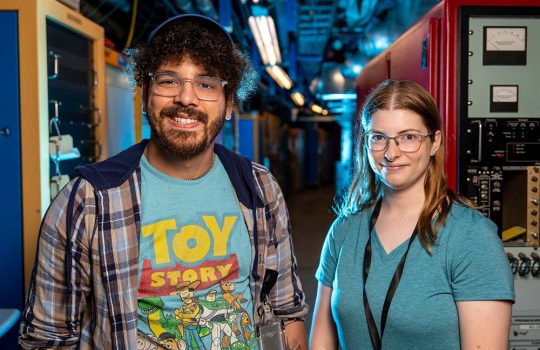
Pranav Sivakumar, a student at the Illinois Math and Science Academy, was recently recognized by President Barack Obama at White House Astronomy Night. Fermilab Ask-a-Scientist and Saturday Morning Physics talks were significant influences in his decision to pursue science. Photo: Reidar Hahn
Pranav Sivakumar, a junior at the Illinois Math and Science Academy, began attending Fermilab public lectures with his parents when he was in the fourth grade.
At first, as one might expect of an elementary school student, Sivakumar didn’t exactly know what was going on at Saturday Morning Physics and Ask-a-Scientist. But the scientists’ enthusiasm enthralled him.
“They really put in a lot of effort, going out of their way to teach. I caught some of that energy, and it’s stuck with me,” said Sivakumar, who is now 15 years old. “Fermilab has motivated me and focused me in the direction I wanted to go.”
This direction turned out to be astrophysics, specifically the study of gravitationally lensed quasars. Quasars are bright objects around black holes. When viewed from Earth, the light from gravitationally lensed quasars bends around a massive galaxy in front of them. This effect makes one quasar appear to be two or more quasars.
“Talking to Fermilab scientists, I realized how important gravitationally lensed quasars were in understanding dark matter and dark energy. This made me want to work with them,” Sivakumar said. Lensed quasars tell scientists about the rate of expansion of the universe, which can provide clues about enigmatic dark matter and dark energy.
For the Google Science Fair, a worldwide online science and technology competition among teens, Sivakumar developed algorithms to identify gravitationally lensed quasar candidates from data taken by the Sloan Digital Sky Survey. The algorithms help determine if two or more images of light are from a single lensed quasar or multiple quasars. With this project, he won the Virgin Galactic Pioneer Award and was one of 20 global finalists.
While working on this project, Sivakumar said he found mentors in two Fermilab scientists, Brian Nord and Chris Stoughton.
“The logic that he used to set up his algorithm is competitive with something that we would do,” said Nord, a research associate. “And he found a lensed quasar that was detected independently by our colleagues. The work that he’s done is something that requires persistence, focus and hard work.”
Soon after being recognized by the Google Science Fair, Sivakumar got a shout-out from President Obama in a speech at the White House Astronomy Night in October. Obama also mentioned how Fermilab’s public programs inspired Sivakumar’s work.
Sivakumar still looks to Fermilab scientists for inspiration and illumination. He recently visited the lab to continue working on an extension of his Google Science Fair quasar project with Fermilab astrophysicists, including Nord.
“We have a plan to work more with Pranav and see how far we can carry these algorithms,” Nord said.
“It’s all been fantastic,” Sivakumar said. “For the future, I want to continue in astrophysics. I’m really enjoying the way things are going.”
And when the President publicly praises you, who wouldn’t?



